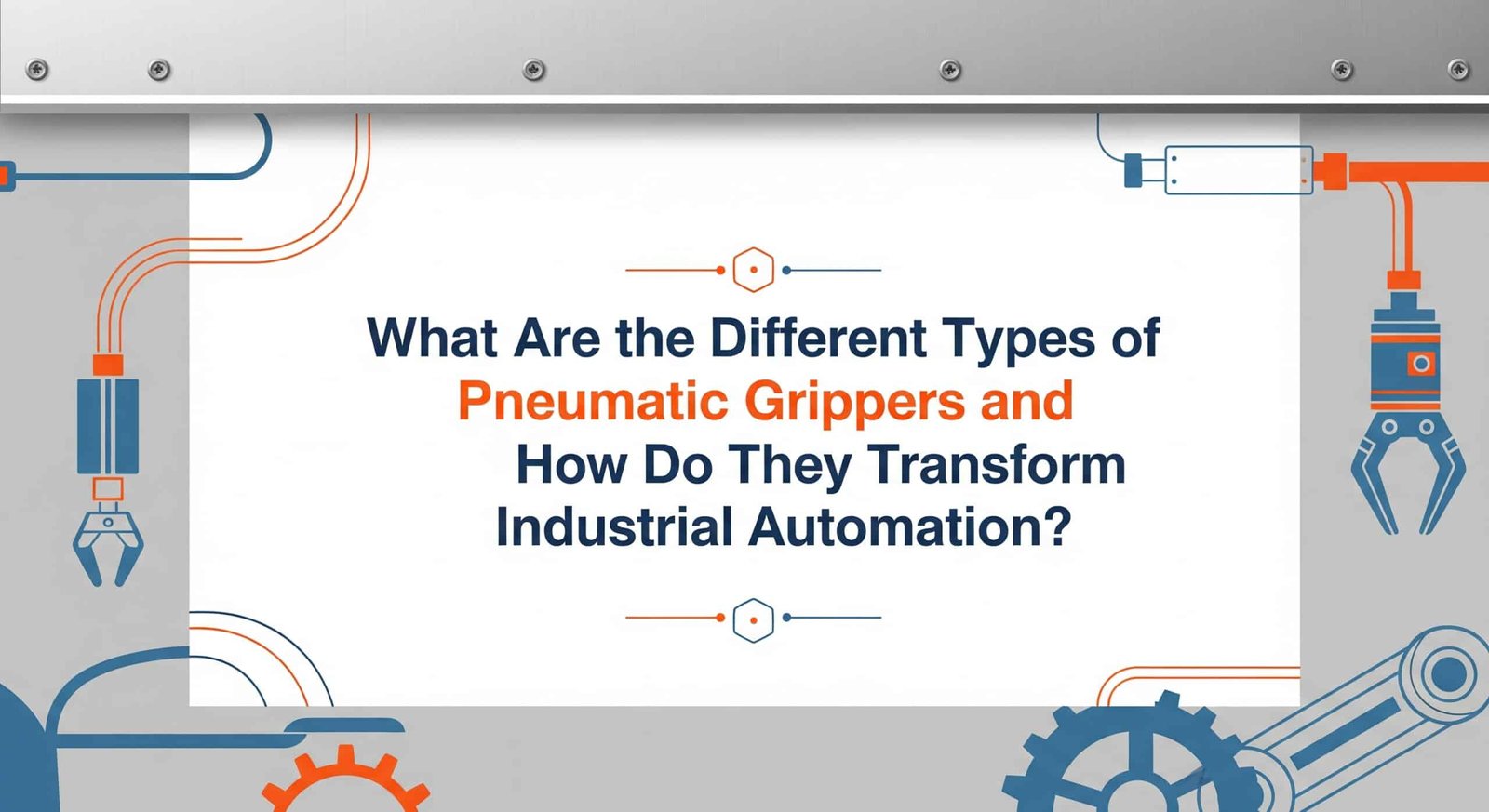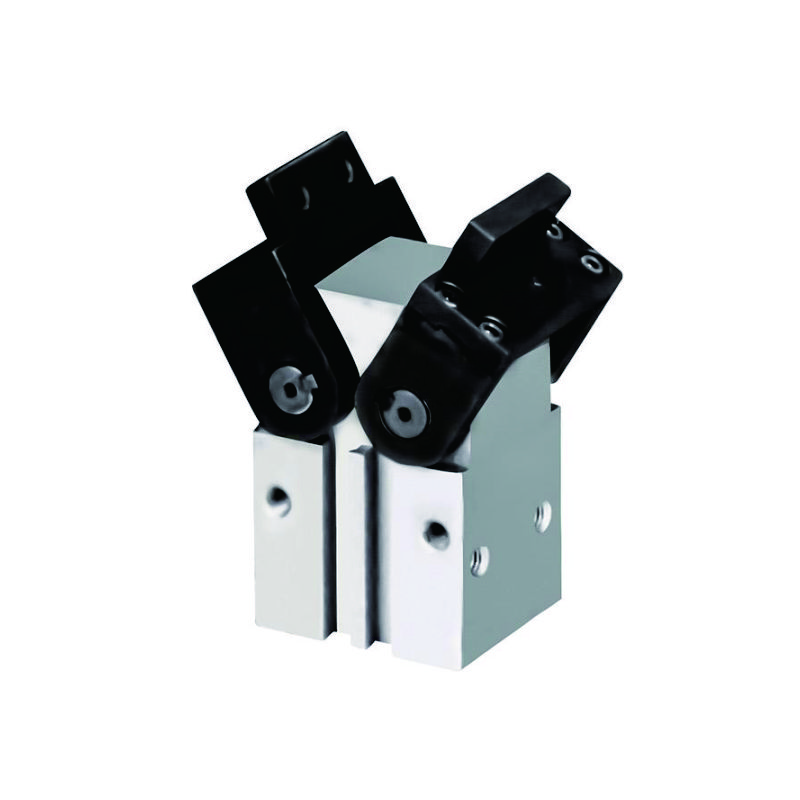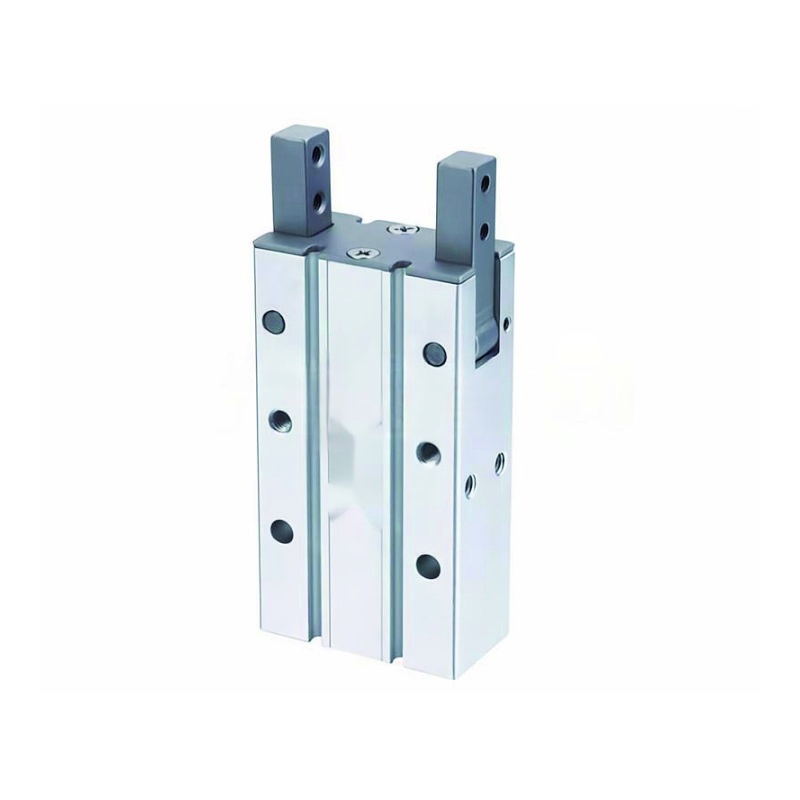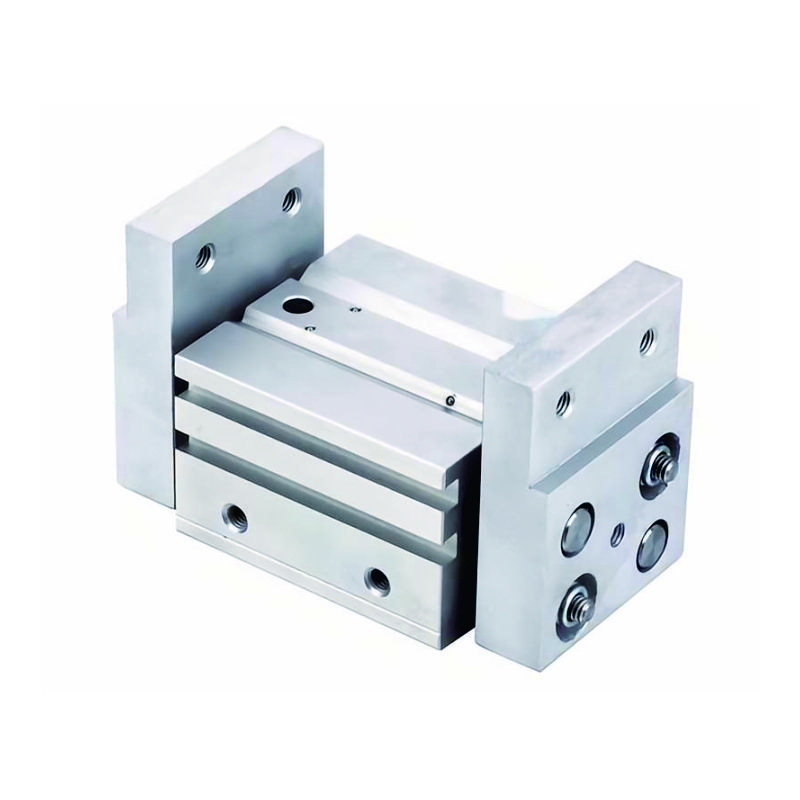When your automated assembly line drops 8% of handled parts due to inconsistent grip force and poor part positioning, costing $12,000 daily in damaged products and rework, the solution often lies in selecting the right pneumatic gripper type that matches your specific application requirements and part characteristics.
Pneumatic grippers come in five main types – parallel, angular, 3-jaw, needle, and toggle grippers – each designed for specific gripping applications, with parallel grippers handling rectangular parts, angular grippers for round objects, and specialized designs for delicate or complex part geometries with grip forces ranging from 10N to 10,000N.
Last month, I helped Lisa Chen, an automation engineer at an electronics assembly facility in San Jose, California, whose existing grippers were damaging delicate circuit boards due to excessive grip force and poor jaw alignment.
Table of Contents
- What Are the Main Categories of Pneumatic Grippers and Their Applications?
- How Do Parallel and Angular Grippers Differ in Performance and Use Cases?
- Which Specialized Gripper Types Handle Unique Industrial Applications?
- Why Do Gripper Selection and Sizing Determine Automation Success?
What Are the Main Categories of Pneumatic Grippers and Their Applications?
Pneumatic grippers are classified into distinct types based on their jaw movement patterns and intended applications in automated handling systems.
The five main pneumatic gripper categories are parallel grippers for rectangular parts, angular grippers for cylindrical objects, 3-jaw grippers for round parts, needle grippers for delicate items, and toggle grippers for high-force applications, with each type optimized for specific part geometries and handling requirements.
Primary Gripper Classifications
In my 15 years at Bepto, I’ve supplied pneumatic grippers for countless automation applications across diverse industries:
Parallel Grippers (Linear Motion)
- Movement: Jaws move in parallel straight lines
- Best For: Rectangular, square, or flat parts
- Industries: Electronics, automotive, packaging
- Advantages: Consistent grip force, precise positioning
Angular Grippers (Rotary Motion)
- Movement: Jaws rotate around pivot points
- Best For: Cylindrical, round, or irregular shapes
- Industries: Machining, material handling, assembly
- Advantages: Self-centering action, versatile gripping
3-Jaw Grippers (Concentric Motion)
- Movement: Three jaws move simultaneously inward/outward
- Best For: Round parts, tubes, rods
- Industries: Machining, turning operations, inspection
- Advantages: Automatic centering, secure round part grip
Needle Grippers (Precision Motion)
- Movement: Thin needle-like jaws for delicate handling
- Best For: Small, fragile, or thin components
- Industries: Electronics, medical devices, optics
- Advantages: Minimal contact area, gentle handling
Toggle Grippers (High-Force Motion)
- Movement: Mechanical advantage through toggle mechanism
- Best For: Heavy parts requiring high grip force
- Industries: Heavy manufacturing, forging, welding
- Advantages: Maximum grip force, self-locking action
Application-Based Selection Matrix
| Part Characteristics | Recommended Gripper Type | Typical Force Range | Key Benefits |
|---|---|---|---|
| Rectangular/Flat | Parallel | 50N – 2000N | Uniform pressure distribution |
| Cylindrical/Round | Angular or 3-Jaw | 100N – 3000N | Self-centering capability |
| Small/Delicate | Needle | 10N – 200N | Minimal part contact |
| Heavy/Robust | Toggle | 500N – 10000N | Maximum grip strength |
| Irregular Shapes | Angular | 200N – 2500N | Adaptive jaw positioning |
Industry-Specific Applications
Automotive Manufacturing
- Engine Components: Angular grippers for pistons, rods
- Body Panels: Parallel grippers for flat sheet metal
- Small Parts: Needle grippers for sensors, connectors
- Heavy Assemblies: Toggle grippers for transmission cases
Electronics Assembly
- Circuit Boards: Parallel grippers with soft jaws
- Components: Needle grippers for chips, resistors
- Connectors: Angular grippers for round housings
- Displays: Specialized grippers with vacuum assist
How Do Parallel and Angular Grippers Differ in Performance and Use Cases?
Parallel and angular grippers represent the two most common pneumatic gripper types, each offering distinct advantages for specific automation applications.
Parallel grippers provide uniform pressure distribution and precise positioning for rectangular parts, while angular grippers offer self-centering capability and versatile gripping for round or irregular objects, with parallel types achieving ±0.1mm repeatability and angular types providing up to 180° jaw rotation.
Parallel Gripper Technology
Operating Mechanism
- Linear Actuator: Rodless cylinder or rack-and-pinion drive
- Jaw Movement: Simultaneous parallel motion
- Force Distribution: Even pressure across jaw face
- Positioning: High repeatability and accuracy
Performance Characteristics
- Repeatability1: ±0.05mm to ±0.2mm
- Grip Force: 50N to 5000N per jaw
- Stroke Length: 5mm to 200mm opening
- Speed: 50-500mm/s jaw velocity
Ideal Applications
- Flat Parts: Sheet metal, panels, plates
- Rectangular Objects: Boxes, blocks, housings
- Precision Assembly: Electronic components, optical parts
- Quality Control: Consistent part orientation
Angular Gripper Technology
Operating Mechanism
- Rotary Actuator: Pneumatic vane or piston drive
- Jaw Movement: Rotational motion around pivot
- Self-Centering: Automatic part alignment
- Adaptive Gripping: Conforms to part geometry
Performance Characteristics
- Rotation Angle: 30° to 180° jaw swing
- Grip Force: 100N to 8000N closing force
- Response Time: 0.1-0.5 seconds full stroke
- Torque Output: 5-500 Nm depending on size
Ideal Applications
- Cylindrical Parts: Pipes, rods, shafts
- Round Objects: Bottles, cans, spheres
- Irregular Shapes: Castings, forgings, molded parts
- Material Handling: Bulk part sorting, orientation
Comparative Performance Analysis
| Performance Factor | Parallel Grippers | Angular Grippers |
|---|---|---|
| Part Centering | Manual alignment required | Automatic self-centering |
| Grip Uniformity | Excellent pressure distribution | Variable based on part shape |
| Positioning Accuracy | ±0.05-0.2mm | ±0.2-0.5mm |
| Part Versatility | Limited to similar geometries | Handles varied shapes |
| Cycle Speed | Very fast (0.1-0.3s) | Moderate (0.2-0.5s) |
| Maintenance | Low – fewer moving parts | Moderate – pivot mechanisms |
Real-World Comparison Story
Six months ago, I worked with David Wilson, a production manager at a consumer goods facility in Manchester, England. His parallel grippers were struggling with cylindrical bottles that required precise centering for label application. The bottles would shift during transport, causing 15% label misalignment and $8,000 daily in rework costs. We replaced the parallel grippers with Bepto angular grippers that automatically centered each bottle, reducing misalignment to under 2% and saving £147,000 annually in waste reduction and improved throughput. The self-centering action eliminated the need for additional positioning sensors, further reducing system complexity. 🎯
Selection Guidelines
Choose Parallel Grippers When:
- Parts have consistent rectangular geometry
- High positioning accuracy is critical
- Fast cycle times are required
- Uniform grip pressure is essential
- Parts are fragile or require gentle handling
Choose Angular Grippers When:
- Parts are cylindrical or round
- Part sizes vary within a range
- Self-centering capability is needed
- Irregular part shapes must be handled
- Adaptive gripping is advantageous
Which Specialized Gripper Types Handle Unique Industrial Applications?
Specialized pneumatic grippers address specific industrial challenges that standard parallel and angular types cannot effectively handle.
Specialized gripper types include 3-jaw grippers for precise round part centering, needle grippers for delicate component handling, toggle grippers for maximum force applications, and custom designs for unique part geometries, with each type engineered to solve specific automation challenges in demanding industrial environments.
3-Jaw Gripper Systems
Technical Design
- Simultaneous Motion: All three jaws move concentrically
- Centering Accuracy: ±0.02-0.1mm repeatability
- Chuck-Style Operation: Similar to lathe chuck mechanism
- Balanced Force: Equal pressure from all contact points
Applications and Benefits
- Machining Operations: Workpiece holding for turning
- Quality Inspection: Precise part positioning for measurement
- Assembly Processes: Round component insertion
- Material Handling: Tube and rod manipulation
Performance Specifications
- Part Diameter Range: 5mm to 300mm
- Grip Force: 200N to 5000N total
- Centering Accuracy: ±0.05mm typical
- Cycle Time: 0.2-0.8 seconds full stroke
Needle Gripper Technology
Precision Design Features
- Minimal Contact Area: Reduces part marking and damage
- Adjustable Force: Precise grip pressure control
- Compact Profile: Access to confined spaces
- Gentle Handling: Ideal for fragile components
Critical Applications
- Electronics Manufacturing: IC chips, resistors, capacitors
- Medical Device Assembly: Surgical instruments, implants
- Optical Components: Lenses, prisms, fiber optics
- Precision Mechanics: Watch parts, small mechanisms
Technical Capabilities
- Grip Force Range: 5N to 500N
- Jaw Thickness: 0.5mm to 5mm
- Positioning Accuracy: ±0.02mm
- Part Weight Capacity: 0.1g to 2kg
Toggle Gripper Systems
High-Force Mechanism
- Mechanical Advantage: 5:1 to 20:1 force multiplication
- Self-Locking2: Maintains grip without continuous air pressure
- Robust Construction: Heavy-duty industrial design
- Emergency Release: Safety features for operator protection
Heavy-Duty Applications
- Forging Operations: Hot metal part handling
- Welding Fixtures: Secure part positioning
- Heavy Assembly: Large component manipulation
- Material Processing: Steel, aluminum, casting handling
Performance Specifications
- Maximum Grip Force: Up to 50,000N
- Part Weight Capacity: 500kg+
- Operating Pressure: 4-8 bar typical
- Safety Factor: 4:1 minimum design margin
Custom Gripper Solutions
Our Bepto engineering team designs specialized grippers for unique applications:
Vacuum-Assisted Grippers
- Hybrid Technology: Pneumatic grip + vacuum hold
- Applications: Porous materials, irregular surfaces
- Benefits: Secure hold on difficult geometries
- Industries: Glass handling, semiconductor, packaging
Soft-Jaw Grippers
- Compliant Materials: Rubber, foam, silicone jaws
- Applications: Delicate surfaces, painted parts
- Benefits: No marking, conforming grip
- Industries: Automotive finishing, electronics, food
Multi-Position Grippers
- Variable Geometry: Adjustable jaw configurations
- Applications: Multiple part sizes, family tooling
- Benefits: Reduced tooling changes, flexibility
- Industries: Job shops, prototyping, small batch
Specialized Gripper Comparison
| Gripper Type | Primary Advantage | Typical Force | Best Applications |
|---|---|---|---|
| 3-Jaw | Perfect centering | 200-5000N | Round parts, machining |
| Needle | Minimal contact | 5-500N | Delicate components |
| Toggle | Maximum force | 1000-50000N | Heavy parts, welding |
| Vacuum-Assist | Versatile holding | 100-2000N | Irregular surfaces |
| Soft-Jaw | Damage prevention | 50-1500N | Finished surfaces |
Why Do Gripper Selection and Sizing Determine Automation Success?
Proper pneumatic gripper selection and sizing directly impact production quality, cycle times, and overall automation system reliability.
Gripper selection and sizing determine automation success through matching grip force to part requirements, ensuring adequate safety factors, optimizing cycle times, and preventing part damage, with proper selection typically improving production efficiency by 25-40% while reducing defect rates by 60-80%.

Critical Selection Parameters
Part Characteristics Analysis
- Geometry: Shape, size, surface features
- Weight: Mass and center of gravity
- Material: Surface hardness, fragility, texture
- Tolerances: Dimensional variations, surface finish
Force Calculation Requirements
- Grip Force: Minimum force to secure part
- Safety Factor: 2-4x minimum for reliability
- Acceleration Forces: Dynamic loads during motion
- Environmental Factors: Temperature, contamination, vibration
Performance Requirements
- Cycle Time: Speed requirements for production rate
- Positioning Accuracy: Repeatability specifications
- Reliability: Expected service life and maintenance
- Integration: Compatibility with existing systems
Sizing Methodology
Force Calculation Formula
Required Grip Force = (Part Weight × Acceleration Factor × Safety Factor) / Coefficient of Friction3
Safety Factor Guidelines
- Standard Applications: 2-3x Safety Factor4
- High-Speed Operations: 3-4x safety factor
- Critical Parts: 4-5x safety factor
- Fragile Components: Minimum force with 1.5-2x factor
Stroke Length Considerations
- Opening Distance: Part size + clearance + tolerance
- Clearance Factor: 20-50% additional opening
- Jaw Thickness: Account for gripper jaw dimensions
- Access Requirements: Space for part insertion/removal
ROI Through Proper Selection
Performance Improvements
Our customers achieve measurable benefits through proper gripper selection:
- Cycle Time Reduction: 15-30% faster operation
- Defect Rate Decrease: 60-80% fewer damaged parts
- Uptime Improvement: 90%+ reliability increase
- Maintenance Reduction: 50% fewer service calls
Cost Impact Analysis
- Initial Investment: Proper gripper selection vs. trial-and-error
- Production Efficiency: Faster cycles, fewer stops
- Quality Costs: Reduced scrap and rework
- Maintenance Savings: Longer service life, fewer failures
Success Story: Complete Gripper Optimization
Three months ago, I partnered with Maria Rodriguez, operations manager at a medical device facility in Barcelona, Spain. Her assembly line was experiencing 22% part damage rates with generic parallel grippers that couldn’t handle the delicate titanium implants properly. The excessive grip force was causing micro-cracks that led to €180,000 monthly in scrapped parts. We conducted a complete gripper analysis and replaced the system with custom Bepto needle grippers with force feedback control. The new system reduced damage rates to under 3%, saving €2.1 million annually while improving cycle times by 28% through optimized grip sequences. 💰
Selection Decision Matrix
| Application Type | Recommended Gripper | Key Selection Factors | Expected Benefits |
|---|---|---|---|
| High-Volume Assembly | Parallel with sensors | Speed, repeatability, reliability | 30% cycle time reduction |
| Varied Part Handling | Angular with soft jaws | Versatility, gentle grip | 50% tooling reduction |
| Precision Operations | 3-jaw with feedback | Accuracy, centering | 80% positioning improvement |
| Delicate Components | Needle with force control | Minimal contact, controlled force | 90% damage reduction |
Bepto Gripper Advantages
Technical Excellence
- Precision Manufacturing: ±0.02mm component tolerances
- Quality Materials: Hardened steel, corrosion-resistant coatings
- Advanced Sealing: Extended service life in harsh environments
- Modular Design: Easy maintenance and customization
Cost-Effectiveness
- Competitive Pricing: 30-50% savings vs. premium brands
- Fast Delivery: 24-48 hours for standard models
- Local Support: Technical assistance and rapid service
- Warranty Coverage: 2-year comprehensive warranty
Application Engineering
- Free Consultation: Gripper selection and sizing support
- Custom Solutions: Tailored designs for unique applications
- Integration Support: Mounting, controls, and system optimization
- Training Programs: Operator and maintenance training
The investment in properly selected and sized pneumatic grippers typically delivers 200-350% ROI through improved productivity, reduced waste, and enhanced system reliability. 📈
Conclusion
Understanding the different types of pneumatic grippers and their specific applications is essential for successful industrial automation, with proper selection directly impacting production efficiency, quality, and profitability.
FAQs About Types of Pneumatic Grippers
What is the difference between parallel and angular pneumatic grippers?
Parallel grippers move their jaws in straight parallel lines for rectangular parts, while angular grippers rotate their jaws around pivot points for cylindrical or irregular objects, with parallel types offering better positioning accuracy and angular types providing self-centering capability. Parallel grippers achieve ±0.05-0.2mm repeatability for flat parts, while angular grippers automatically center round objects with ±0.2-0.5mm accuracy, making each type optimal for different part geometries.
How do I calculate the required grip force for my pneumatic gripper application?
Required grip force equals part weight times acceleration factor times safety factor, divided by coefficient of friction, with typical safety factors of 2-4x and acceleration factors of 1.5-3x depending on motion speed and direction. For example, a 2kg part moving at 2g acceleration with 0.3 friction coefficient requires minimum 40N grip force, but we recommend 80-120N with safety factor for reliable operation.
Which pneumatic gripper type is best for handling delicate electronic components?
Needle grippers with adjustable force control are ideal for delicate electronic components, providing minimal contact area and precise grip pressure from 5-200N to prevent damage while maintaining secure holding. These grippers feature thin jaws (0.5-2mm) that minimize contact stress and include force feedback systems to prevent over-gripping of fragile parts like circuit boards, sensors, and optical components.
Can pneumatic grippers handle both small and large parts with the same system?
Multi-position grippers with adjustable jaw configurations can handle part size variations within a 3:1 ratio, while gripper changers allow automatic switching between different gripper types for maximum versatility. For applications requiring broader size ranges, we recommend modular gripper systems with quick-change capabilities or servo-controlled variable-geometry grippers that adapt to different part dimensions automatically.
How often do pneumatic grippers require maintenance and what are common failure modes?
Pneumatic grippers typically require maintenance every 6-12 months depending on usage, with common issues including seal wear, jaw misalignment, and contamination buildup, with 80% of problems preventable through proper air filtration and regular lubrication. Our Bepto grippers include diagnostic features that monitor grip force and jaw position to predict maintenance needs, with typical service life exceeding 10 million cycles when properly maintained and operated within specifications.
-
Learn the critical difference between repeatability and accuracy in automation systems. ↩
-
Explore the engineering principle of self-locking and how it creates stable holding force without continuous power. ↩
-
Review a guide on the coefficient of friction, including tables for various material pairings. ↩
-
Access an engineering guide on how to select an appropriate Factor of Safety (FoS) in mechanical design. ↩






